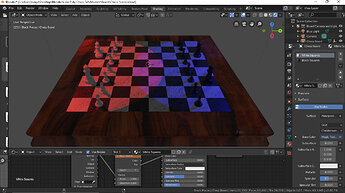So I like the black textures I played a lot with them, but I could find any that would match them for the white ones. When I tried to use the same setting the white color just blended in so I decided to go with these… I would like to hear your opinion and maybe some advice 
I wonder if it would be better if the black and white squares had separate node set ups so the texture effect lines did not transition smoothly from the black to the white, as though it was one material with two colours?
Its quite a nice effect but not what the eye expects, its not obviously some natural material like a marble or other stone.
They had 2 separate nodes as you can see in the picture this set up was for white squares. If that’s what you mean…  I don’t know why they connected so smoothly but I changed the Texture coordinate to UV for white squares and they don’t connect anymore.
I don’t know why they connected so smoothly but I changed the Texture coordinate to UV for white squares and they don’t connect anymore.
Also yes I know that it isn’t some natural material but I don’t mean for the board to be realistic so I don’t mind that for now. But if I was to go for a realistic look I would change that of course.
Most people, including me, will use everything what they learned into on project. But often “Less is more”. Especially when it comes to real life objects, like a chessboard.
You know what to expect when you see a chessboard. When it’s deviate from the concept of a chessboard, it will look odd.
So, the chessboard challenge is more a one of being realistic, than one of creativity.
And playing with nodes, using random texture generators, will not help either. And will take a lot of fiddling around to stumble upon a nice texture. As you just have learned with the black and white fields.
Ah ok. I will keep that in mind and play with the board a little bit more, try to change it to the more realistic look and than add the new photo to this thread. Thank you for your opinion it helps me out a lot to see what I’m doing wrong or what I could improve 



